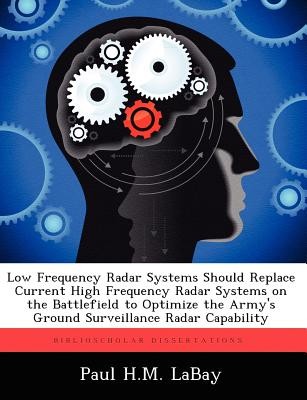
- We will send in 10–14 business days.
- Author: Paul H M Labay
- Publisher: BiblioScholar
- ISBN-10: 1249372011
- ISBN-13: 9781249372011
- Format: 18.9 x 24.6 x 0.6 cm, softcover
- Language: English
- SAVE -10% with code: EXTRA
Low Frequency Radar Systems Should Replace Current High Frequency Radar Systems on the Battlefield to Optimize the Army's Ground Surveillance Radar Capability (e-book) (used book) | bookbook.eu
Reviews
Description
One of the key requirements for U.S. maneuver forces to be able to win the first battle is the quick and accurate location of engaged enemy units in the battle area. At present and into the foreseeable future, ground surveillance radar will continue to provide the maneuver commander with a substantial part of this immediate intelligence information of-the-art technology provides the Army with two distinct types of radar to accomplish the ground surveillance radar mission. The first is a high frequency, line-of-sight system; the second is a low frequency, foliage independent system. Because monetary and manpower constraints will limit the types and numbers of radar systems eventually deployed, the Army must choose that system which best fulfills its ground surveillance radar needs. This paper investigates the efficacy of both systems to detect, locate, and identify targets of military interest under stated evaluative conditions. It addresses both the machine and the man-machine/human factors aspects of radar operation. The demonstrated capabilities of both systems are compared and evaluated to determine which system shows the greatest potential to optimize the Army's ground surveillance radar capability. The study concludes that low frequency radar systems offer the best practical solution to finding the enemy. It further recommends that the Army place priority effort into developing low frequency radar systems for future ground use.
EXTRA 10 % discount with code: EXTRA
The promotion ends in 16d.07:55:45
The discount code is valid when purchasing from 10 €. Discounts do not stack.
- Author: Paul H M Labay
- Publisher: BiblioScholar
- ISBN-10: 1249372011
- ISBN-13: 9781249372011
- Format: 18.9 x 24.6 x 0.6 cm, softcover
- Language: English English
One of the key requirements for U.S. maneuver forces to be able to win the first battle is the quick and accurate location of engaged enemy units in the battle area. At present and into the foreseeable future, ground surveillance radar will continue to provide the maneuver commander with a substantial part of this immediate intelligence information of-the-art technology provides the Army with two distinct types of radar to accomplish the ground surveillance radar mission. The first is a high frequency, line-of-sight system; the second is a low frequency, foliage independent system. Because monetary and manpower constraints will limit the types and numbers of radar systems eventually deployed, the Army must choose that system which best fulfills its ground surveillance radar needs. This paper investigates the efficacy of both systems to detect, locate, and identify targets of military interest under stated evaluative conditions. It addresses both the machine and the man-machine/human factors aspects of radar operation. The demonstrated capabilities of both systems are compared and evaluated to determine which system shows the greatest potential to optimize the Army's ground surveillance radar capability. The study concludes that low frequency radar systems offer the best practical solution to finding the enemy. It further recommends that the Army place priority effort into developing low frequency radar systems for future ground use.


Reviews